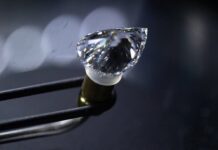
In September 2016, GIA’s Hong Kong laboratory tested a 10.08 ct blue synthetic diamond grown by the high-pressure, high-temperature (HPHT) method. This was the largest HPHT synthetic diamond recorded to date. It was also the largest HPHT blue synthetic diamond GIA has examined, surpassing a 5.27 ct sample examined by the Hong Kong lab in May 2016 (see more on the two previous record holders). The manufacturer of all three stones is New Diamond Technology (NDT) in St. Petersburg, Russia.
The 10.08 ct emerald cut measured 13.54 × 11.39 × 7.36 mm and had a color grade equivalent to Fancy Deep blue (figure 1). The client submitted the stone for scientific examination and disclosed that it was a synthetic diamond. Magnification revealed very weak color zoning with a banded structure. A few very small metallic inclusions and fractures were observed, resulting in a clarity grade equivalent to SI1. Microscopic examination with crossed polarizers showed no detectable strain, indicating a very low density of dislocations. Fluorescence images collected using the DiamondView revealed the distinctive “hourglass” growth pattern, which are significant in revealing HPHT growth. Strong blue phosphorescence, another indicator, was also detected. These images were dominated by the {111} growth sector, which had much stronger blue fluorescence. The {100} growth sector with very weak fluorescence was much smaller, indicating this synthetic diamond was produced with dominant octahedral growth. It also exhibited a strong red-orange fluorescence to long-wave UV radiation and a yellow fluorescence to short-wave UV (figure 2), both of which are uncommon.

Infrared absorption spectroscopy confirmed this was a type IIb diamond, with a strong absorption band at ~2800 cm–1 in its infrared absorption spectrum attributed to boron impurity. Photoluminescence analysis was conducted at liquid nitrogen temperature with varying laser excitations showed it was surprisingly pure, with no detectable impurity-related emissions.
Based on these gemological and spectroscopic features, we concluded that this sample was an HPHT synthetic diamond. This offered another indication of the rapid progress in HPHT synthetic technology, which offers an option for the diamond jewelry industry as well as many promising industrial and research applications. NDT also plans to offer large colorless and blue HPHT-grown diamonds made from unique donor carbon “DNA,” such as car leather and wood trim that have been turned into ultra-clean graphite. With standard protocols in place at GIA laboratories, every type of synthetic diamond on the market can be confidently identified.
News Source : gia.org
Disclaimer: This information has been collected through secondary research and TJM Media Pvt Ltd. is not responsible for any errors in the same.


























